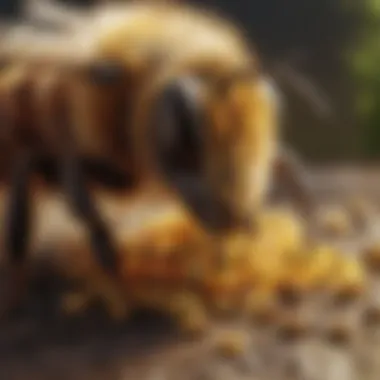Strategic Actions to Prevent Bee Extinction


Intro
The plight of bee populations is an urgent matter that cannot be ignored. As essential pollinators, bees play a vital role in our ecosystem, significantly influencing crop yields and biodiversity. Their decline can lead to disastrous effects on food security and natural landscapes. Understanding the actions necessary to prevent bee extinction is crucial for farmers, environmentalists, and policymakers.
The objective of this discussion is to articulate strategic actions that can be taken to safeguard bee populations. Focusing on practical methodologies and the significance of these efforts will empower various stakeholders to contribute effectively. By adopting a collaborative approach, we can create a sustainable future for both bees and the ecosystems they support.
Topic Overview
Definition and Importance
Bees are not just insects that buzz around flowers; they are indispensable players in the agricultural sector. Their role extends beyond mere pollination—they are key facilitators of plant reproduction. Pollination contributes to over 75% of global food crops. Hence, the survival of bee species directly ties to food availability and nutritional diversity.
Brief History and Evolution
Historically, bee populations flourished under natural ecosystems. However, advancements in agriculture and urbanization have markedly altered their habitats. From the introduction of monoculture farming to the increased use of pesticides, several factors have contributed to the decline of bees. A comprehensive understanding of their evolutionary history highlights the need for immediate intervention.
Key Techniques and Innovations
Sustainable Farming Practices
Sustainable farming is essential for protecting bee habitats. Some practices include:
- Reducing pesticide use, especially neonicotinoids, which are highly toxic to bees.
- Planting cover crops to provide habitat and forage.
- Utilizing organic farming techniques to enhance soil health and biodiversity.
These strategies promote a healthy ecosystem which benefits not only bees but also other organisms.
Advanced Agronomic Technologies
Innovations in agriculture can aid bee conservation efforts. Techniques such as precision agriculture can minimize chemical inputs and their negative effects on bee populations. Integrating technology with traditional farming can help monitor bee health and activity in real-time, enabling timely interventions when necessary.
Practical Applications
Step-by-Step Guides
Implementing strategies takes planning and organization. Here’s a general guide to mitigate bee extinction:
- Conduct an assessment of current farming practices.
- Identify areas where bee-friendly practices can be integrated.
- Engage with local beekeeping associations for collaboration and knowledge exchange.
- Monitor the effects of your changes over time to ensure effectiveness.
Case Studies or Real-World Examples
Several regions have initiated successful programs to preserve bee populations. For instance, places like Germany and France are implementing policy changes targeted at reducing loss of bee habitats and enhancing biodiversity. These case studies provide valuable insights that can inspire similar actions in other areas.
"The decline of bees is a bellwether for the health of our ecosystems, and taking collective action is paramount to ensure their survival."
Understanding the urgency of these actions establishes a foundation for proactive, strategic efforts aimed at bee conservation. The time to act is now.
For further reading, consider visiting Wikipedia or Britannica.
The Importance of Bees in Ecosystems
Bees play a crucial role in maintaining the health and sustainability of our ecosystems. Their presence is vital for the reproduction of many flowering plants. This, in turn, supports various forms of life, from insects to mammals. Understanding their value helps highlight why actions to prevent their decline are so necessary.
Bees as Pollinators
Bees are one of the most effective pollinators in nature. They facilitate the pollination process by transferring pollen from the male parts of flowers to the female parts. This process is essential for the fertilization of plants, leading to the production of fruits and seeds. It is estimated that bees contribute to 75% of the world’s food crops. Without their work, many fruits, vegetables, and nuts would become scarce, impacting food availability for humans and animals alike. Key crops such as apples, almonds, and blueberries depend entirely on bee pollination.
Moreover, the role of bees extends beyond agricultural crops; they also pollinate wild plants that provide habitat and food for other wildlife. The decline of bee populations thus threatens not only food security but also natural ecosystems.
Contribution to Biodiversity


The contribution of bees to biodiversity is profound. Pollination resulting from bees helps create genetic diversity in plants. This variety is vital for ecosystem resilience and adaptability to changing environments. When bee populations are robust, they promote a wider range of plants, which supports various animal species as well.
A few points to consider regarding their contribution to biodiversity include:
- Wildflower Populations: Bees support countless wildflower species which serve as habitats for a variety of organisms.
- Ecosystem Health: A diverse plant life leads to healthier ecosystems that can better withstand pests, diseases, and climate changes.
- Food Web Stability: Bees help sustain food webs, making ecosystems more stable by providing food sources for other organisms.
"If we lose our bees, we risk extensive biodiversity loss, which could destabilize ecosystems and lead to serious environmental impacts."
In summary, the importance of bees in ecosystems cannot be overstated. They are essential for pollination, supporting food production, and maintaining biodiversity. Recognizing their role provides a solid foundation for understanding the urgency in implementing strategic actions to prevent their extinction.
Current State of Global Bee Populations
The current state of global bee populations is a critical concern that impacts various ecosystems. Bees serve as essential pollinators, and their decline threatens the stability of food sources and biodiversity. Understanding their status allows for informed actions to combat extinction and promote conservation. Global data reveals alarming trends in bee populations, prompting the need for strategic conservation efforts.
Statistics and Trends in Bee Decline
Statistical data illustrates a pronounced decline in bee populations over the last few decades. According to recent studies, some bee species have seen a decrease of up to 50% in their populations. For instance, the Rusty Patched Bumble Bee is now listed as endangered in the United States. The European Union reports that at least 25% of wild bee species are facing extinction. The trends indicate a worrying pattern of disappearing bee colonies. Factors such as habitat loss, climate change, and pesticide exposure have heavily influenced these unfortunate statistics.
Primary Threats to Bee Survival
Understanding the primary threats to bee survival is essential for implementing effective conservation strategies. The most significant threats include:
- Pesticide Use: Chemical pesticides, particularly neonicotinoids, have been shown to adversely affect bee health, leading to reduced reproductive capabilities and increased mortality rates.
- Habitat Loss: Urbanization and intensive farming practices eliminate habitats crucial for bee forage and nesting. This fragmentation restricts their ability to thrive in natural environments.
- Climate Change: Changing weather patterns disrupt foraging behaviors and flowering times, causing mismatches that can jeopardize bee nutrition.
- Diseases and Parasites: Bees face many health challenges, including parasitic mites like Varroa destructor, which weaken colonies and make them susceptible to diseases.
Understanding the Causes of Bee Decline
The decline in bee populations is a multifaceted issue that arises from various interrelated causes. Understanding these causes is pivotal for any strategic actions aimed at preventing their extinction. Bees play a crucial role in our ecosystems through pollination, which is essential for the reproduction of many plants. Consequently, the decline in bee populations may have dire consequences for plant biodiversity and food production. This section examines the primary reasons for bee decline, providing a foundation for the solutions discussed later in this article.
Pesticide Usage and Its Impacts
Pesticides are commonly used in agriculture to protect crops from pests and diseases. However, the use of certain pesticides, especially neonicotinoids, has been linked to detrimental effects on bee health. These chemicals can impair the foraging behavior of bees, reduce reproductive success, and even lead to death. Studies suggest that sublethal doses can cause cognitive impairments, making it difficult for bees to navigate and find food sources. The increased reliance on pesticides not only harms bees but disrupts the entire ecosystem, creating imbalances that can lead to wider environmental issues. Farmers and agricultural enthusiasts must consider integrated pest management practices, which can reduce reliance on harmful chemicals, thereby protecting bee populations.
Habitat Loss and Fragmentation
Urbanization and intensive agricultural practices have led to significant habitat loss for bees. The conversion of natural landscapes into agricultural land or urban areas fragments crucial habitats, isolating bee populations and reducing their foraging options. This fragmentation limits the availability of wildflowers and nesting sites, which are vital for bee survival. Additionally, monoculture farming enhances habitat loss, as it reduces the variety of plants that bees depend on for their nutrition. To mitigate these effects, it is essential to create corridors of natural habitats and implement agroecological practices that encourage biodiversity on farms.
Climate Change Effects
Climate change is posing a serious threat to bee populations through altered weather patterns and changing flowering times of plants. Rising temperatures can shift the distributions of both bees and their food sources, leading to mismatches in pollination. For example, if certain plants bloom earlier due to warmer temperatures while bees remain inactive, pollination may be ineffective. Furthermore, extreme weather events, such as storms and droughts, can destroy nesting sites and reduce available forage. Addressing climate change through sustainable farming practices and reduced carbon emissions is thus essential for the health of bee populations.
Disease and Parasite Pressures
Bees are vulnerable to several diseases and parasites, most notably the Varroa destructor mite, which has greatly impacted honey bee populations globally. This mite attaches to bees and feeds on their bodily fluids, weakening them and making them susceptible to viruses. Disease outbreaks can spread rapidly in colonies, leading to severe declines. Additionally, factors like poor nutrition and stressful environmental conditions can amplify the negative effects of diseases and parasites. Beekeepers and farmers must engage in better management practices, such as monitoring bee health and reducing stressors, to help combat these threats to bee survival.
"Understanding the causes of bee decline is integral to developing effective strategies for their conservation. Each factor interplays with others, creating a complex web that affects these essential pollinators."
Sustainable Agricultural Practices
Sustainable agricultural practices are crucial in the fight against bee extinction. These methods aim to create a harmonious balance between farming needs and the preservation of the ecosystem, particularly the health of bee populations. By adopting sustainable techniques, farmers can not only increase their yields but also contribute to the long-term viability of bee species that are essential for pollination.
Organic Farming Techniques
Organic farming techniques play a vital role in supporting bee populations. This approach excludes synthetic pesticides and fertilizers, reducing chemical exposure to bees. Organic methods focus on natural inputs and processes, fostering a healthier environment for pollinators.
Incorporating cover crops, for instance, can improve soil health and provide foraging resources for bees. Additionally, organic farming often emphasizes biodiversity by promoting a variety of crops, which supports diverse bee species.
Research shows that organic farms can support 50% more bee species compared to conventional farms, highlighting their significance in bee conservation.
Crop Rotation and Diversity
Crop rotation and diversity are integral to sustainable practices. Rotating crops reduces soil depletion and combats pest issues without relying heavily on chemicals. Introducing various plants in the fields enhances biodiversity, which is beneficial for bees. Different plants bloom at different times, providing consistent food sources throughout the growing season.


Farmers should plan rotations carefully to include flowering plants. This will not only enrich soil health but also attract and sustain bee populations. Moreover, planting hedgerows and wildflowers within or around fields can create additional environments that support pollinators.
Creating Bee-Friendly Habitats
Creating bee-friendly habitats within agricultural landscapes is achievable and immensely beneficial. This practice includes setting aside portions of land where wildflowers and native plants can grow freely. These areas act as sanctuaries for bees, providing essential food sources and nesting sites.
Farmers can implement several strategies to enhance habitats:
- Establishing uncultivated strips along field borders.
- Planting diverse flower beds that bloom throughout the season.
- Minimizing tillage practices to protect ground-nesting bee species.
By prioritizing bee-friendly habitats, agricultural landscapes can become resilient ecosystems that support both farming and biodiversity, leading to healthier bee populations.
Community and Individual Efforts
Community and individual efforts play a crucial role in the fight against bee extinction. Bees are essential for pollinating a significant portion of our food supply and contribute massively to biodiversity. When communities come together, they can create substantial changes. Individuals also have the power to contribute, often in surprisingly effective ways. By focusing on local actions and creating bee-centered initiatives, a ripple effect can commence.
Urban Beekeeping Initiatives
Urban beekeeping has gained traction in many cities around the world. This practice not only promotes awareness about the value of bees but also improves their habitat. In dense urban environments, gardens and rooftop spaces become potential sanctuaries for bees. These initiatives allow individuals to engage directly with beekeeping, providing both education and experience.
The benefits of urban beekeeping include:
- Improved Pollination: Bees pollinate plants in urban gardens, which can enhance local food production.
- Awareness and Education: As people observe and care for bees, they also learn about their significant role in the ecosystem.
- Community Building: Urban beekeepers often form groups, sharing knowledge and creating a strong network of community support.
Points to Consider
Before starting an urban beekeeping project, potential beekeepers should consider local regulations, as some municipalities have restrictions. Additionally, choosing bee species that adapt well to urban life is important. Keeping bees healthy is a responsibility that should not be taken lightly.
Local Advocacy and Education Programs
Local advocacy and education programs are vital in fostering an environment where bees can thrive. These initiatives often aim to educate the public about the challenges bees face and the actions that can be taken to support them. Schools, museums, and community centers can serve as hubs for educational events.
Such programs can include:
- Workshops: Hands-on workshops about beekeeping, gardening for pollinators, and bee biology can provide valuable knowledge.
- Public Campaigns: Local campaigns that raise awareness about pesticide usage, habitat loss, and climate change keep the conversation ongoing.
- Partnerships with Local Farms: Collaboration with agricultural stakeholders can enhance understanding and promote pollinator-friendly practices.
"We can't just rely on experts to save the bees; education and participation at the community level are crucial for change."
Role of Policy and Legislation
The frameworks established by policy and legislation serve as a backbone for efforts to protect bee populations from decline. By instituting clear regulations and guidelines, governments can influence agricultural practices and encourage sustainable methods that enhance bee health and habitats. This role is critical, as it addresses systemic issues and promotes long-term solutions rather than temporary fixes.
Government Regulations on Pesticides
Government regulations on pesticides are crucial to safeguarding bee populations. Pesticides can severely impact bee health, leading to a decline in their numbers. Regulations must focus on:
- Restricting Harmful Chemicals: Certain chemicals are particularly harmful to bees. Governments must identify these substances and limit their use in agriculture.
- Promoting Safer Alternatives: Encouraging farmers to adopt less harmful options can mitigate risks. Education on integrated pest management (IPM) is essential for this shift.
- Setting Usage Guidelines: Establishing clear guidelines on when and how pesticides can be applied reduces exposure to bees during their active periods.
By enforcing such regulations, governments can create environments that not only protect bees but also encourage sustainable agriculture.
Conservation Policies for Pollinators
Conservation policies specifically aim to create safe habitats for pollinators, focusing on enhancing the environments where these species thrive. Effective policies entail:
- Habitat Restoration Projects: Initiatives that restore degraded habitats help revive bee populations. These projects can range from rewilding agricultural lands to preserving natural landscapes.
- Support for Pollinator-Friendly Practices: Incentives for farmers who adopt pollinator-friendly practices play a key role. This includes support for cover crops, flowering land borders, and diversified cropping systems.
- Funding Research Initiatives: Governments can help facilitate research into pollinator health, diseases affecting bees, and the long-term effects of pesticides. Informing policy with scientific evidence is essential for effective regulation.
"Conservation policies for pollinators provide a structured approach to protect and enhance environments for bees and other vital species."
Monitoring and Research Initiatives


Monitoring and research initiatives play a critical role in addressing the challenges facing bee populations. Effective strategies for bee conservation heavily rely on understanding the factors that contribute to their decline. This involves comprehensive data collection, analysis, and dissemination. Without well-organized monitoring efforts, it is challenging to determine the statuses and trends in bee populations worldwide. Thus, fostering an approach based on solid research allows stakeholders and other involved parties to make informed decisions.
Tracking Bee Populations Worldwide
Tracking bee populations is a vital action in preventing extinction. Understanding the shifts in bee numbers globally enables researchers, conservationists, and farmers to address specific areas of concern. National and international programs, such as the Bumblebee Conservation Trust, have developed monitoring protocols that involve citizen scientists. These initiatives bring together communities to document bee sightings and monitor changes in distribution over time.
- Enhancing Data Collection: Organizations track variables such as environmental factors, habitat conditions, and agricultural practices. Analyzing this data helps establish a link between these factors and bee population changes.
- Global Collaboration: International cooperation among researchers can help address knowledge gaps. Collaborative studies project trends in bee populations and predict potential outcomes based on different scenarios.
- Targeted Conservation Efforts: By knowing where specific bee species thrive or decline, targeted preservation actions can be put into place. Information from these tracking efforts helps prioritize conservation sites, ensuring that efforts are channeled effectively.
The insights gained from these initiatives may guide policy development and practical conservation actions.
"Monitoring initiatives provide valuable insights, which can shape conservation efforts and restore bee populations."
Impact Studies on Pollinator Health
Impact studies focusing on pollinator health seek to understand the intricate relationships between different stressors and their effect on bees. Factors like pesticide exposure, habitat change, and climate variations all influence pollinator health. Examining these interactions sheds light on the broader implications for ecosystems.
- Pesticide Effects: Research into how different pesticides impact bee survival can lead to better regulations. Understanding sub-lethal effects, such as impaired foraging or reproduction, is essential.
- Habitat Health: Ensuring that bees have access to suitable habitats is crucial. Studies focusing on floral diversity and availability help determine the most beneficial environments for these vital pollinators.
- Disease Resistance: Investigating diseases and parasites affecting bee populations can uncover necessary management strategies. Research may reveal how bees adapt to pathogens and help enhance resilience.
Understanding these aspects not only enriches our knowledge but also aids in policy formation. Studies focusing on these elements can enhance agriculture by promoting practices that are beneficial for pollinator health.
Emphasizing research and monitoring efforts provides the foundation for strategic actions aimed at safeguarding bee populations.
Innovations in Bee Conservation
Innovations in bee conservation are essential in the quest to combat the ongoing decline in bee populations. These advancements not only help in understanding the threats that bees face but also introduce practical solutions that can be implemented at various levels. From farmers to policymakers, innovative strategies provide a framework for protecting these crucial pollinators. Implementing such innovations can lead to a more resilient ecosystem, greater agricultural productivity, and improved biodiversity.
Technological Advancements
Technological advancements play a pivotal role in bee conservation by integrating new tools and methods into traditional practices. These technologies can range from monitoring systems to comprehensive data analysis platforms. For instance, smart hives equipped with sensors allow beekeepers to track real-time hive health indicators. This information helps in timely interventions which can prevent potential losses in bee populations.
Moreover, drones are increasingly used for surveying bee habitats. They can identify areas that lack floral resources or are suffering from habitat fragmentation. By mapping these landscapes, conservationists can pinpoint critical regions that need protection or restoration.
Other beneficial technologies include apps that facilitate community engagement in beekeeping and monitoring. These tools streamline data collection, helping both citizens and scientists gather valuable information about bee behaviors and populations. By enabling easy access to factual information, these advancements create a more informed and proactive public.
Citizen Science Contributions
Citizen science is an invaluable asset in bee conservation efforts. It engages the general public, inspiring individuals to contribute to scientific research in their neighborhoods. By involving citizens in monitoring bee populations, researchers can gather vast amounts of data across varied landscapes, providing insights that would be difficult to achieve otherwise.
For example, platforms like iNaturalist enable users to document and share their bee sightings. This data is crucial for understanding population trends and fluctuations. Additionally, engaging citizens helps to increase awareness about the importance of bees. As individuals become more knowledgeable about the threats facing bees, they are likely to advocate for change within their communities, enhancing conservation efforts at a grassroots level.
"Involving the community in bee conservation creates a sense of ownership and responsibility, essential for long-term sustainability."
Future Directions for Bee Conservation
The future of bee conservation is a crucial subject that encompasses innovative strategies and collaborative initiatives aimed at reversing the decline in bee populations. As awareness of bees' significance grows, thinking ahead about conservation policies and practices becomes vital. This section will explore two main avenues: integrating conservation with agriculture and the importance of global collaboration.
Integrating Conservation with Agriculture
Agriculture serves as a double-edged sword for bee conservation. On one side, intensive farming practices lead to habitat destruction and chemical exposure, adversely impacting bee populations. On the other, a balance can be found where agricultural practices enhance conservation outcomes. Integrating conservation measures in agricultural systems is essential for sustainable food production while protecting pollinators.
Farmers can adopt various practices to support bee populations. For instance, implementing cover crops can enhance soil quality and provide forage for bees. Additionally, reducing pesticide usage or opting for organic alternatives can minimize harmful exposures. Creating buffer zones with native plants alongside farm fields can also provide vital habitats.
Consider these steps for integrating conservation with agriculture:
- Educate Yourself: Understand the ecological needs of local bee species.
- Support Pollinator Health: Implement practices that reduce pesticide impact.
- Foster Biodiversity: Promote a diverse crop rotation that benefits both bees and soil health.
- Plant Native Species: Use local flowering plants to provide forage through growth cycles.
This holistic approach not only aids in protecting bee populations but can improve crop yields and farm sustainability.
Calls for Global Collaboration
The challenges facing bees are not limited to one region or country; they are global in nature. Therefore, international collaboration is essential for effective bee conservation. Establishing partnerships between governments, NGOs, researchers, and farmers can amplify the impact of conservation strategies.
Global collaboration can take many forms:
- Shared Research Initiatives: Countries can pool resources and knowledge to study bee populations and their needs.
- International Agreements: Similar to agreements on climate change, nations can come together to establish binding commitments aimed at protecting pollinator habitats.
- Funding and Resources: Wealthier nations or organizations can provide financial aid to developing regions to enhance local farming practices and promote biodiversity.
- Public Awareness Campaigns: Collaborative efforts can raise awareness worldwide about the importance of bees and inspire collective action.
Engagement at all levels will lead to a more profound understanding of the threats bees face and what can be done to support them. Only through unified action can we hope to create a sustainable environment where bees can thrive.



